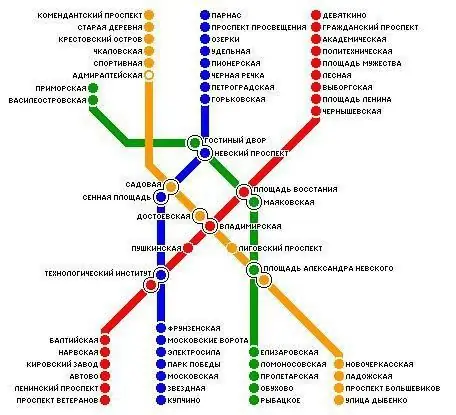- Author Harold Hamphrey [email protected].
- Public 2023-12-17 10:06.
- Last modified 2025-01-24 11:10.
The first plans to build a subway in the capital of the Russian Empire existed at the end of the nineteenth century. They were not abstract. Leading Russian engineers worked on the development of the country's first urban underground railway. Gradually, the future metro scheme of St. Petersburg loomed. But the First World War and everything that followed it prevented it from becoming a reality.
Leningrad Metro
In 1918 the city on the Neva lost its capital status. Consequently, the subway could appear in it only after it was built in Moscow. Nonetheless? its creation began in the late thirties and was interrupted by the Great Patriotic War.
It would not be an exaggeration to say that the current metro scheme of St. Petersburg really came into being in 1955. Of course, this was only the very first relatively small piece of it. But it was in the autumn of 1955 that the first passengers drove along the launch site of the Kirovsko-Vyborg line.
The construction of the Leningrad Metro was very difficult. The territory on which the city is located has a very complex geological structure. Builders had to overcome areas with difficult terrain andmany water barriers. But at the same time, it is impossible not to note the level of engineering solutions - the metro scheme of St. Petersburg is quite rational. It managed to avoid some significant mistakes made in the design of the Moscow subway.

Districts of St. Petersburg with the metro scheme
The fundamental difference between the Leningrad metro and the Moscow metro was the rejection of the radial-ring system. This important decision was made at the design stage. The metro scheme of St. Petersburg is designed in such a way that all its lines connect the densely populated areas of the outskirts with the historical center of the city. Each of them has intersections and interchange stations with the rest. And this provides an opportunity to get from one district of St. Petersburg to any other with a single transfer or without it at all.
Lines of the St. Petersburg metro are quite long and connect districts located at opposite ends of the city through the center. Thus, one path connects the Kirovsky and Vyborgsky districts of St. Petersburg, and the other - the historical Moscow and Petrograd sides.

Prospects for development
The St. Petersburg metro system, which has already been formed and continues to develop, reliably provides communication with all districts of the city. She has already gone beyond its administrative boundaries in the direction of the Leningrad region. Today there are 67 metro stations in St. Petersburg, located on five lines. There are 7 interchange nodes.
Existing development plansthe metro system provides for the emergence of more than thirty new stations in the city for the period up to 2025. They will be located both on the extensions of existing lines and on the new Krasnoselsko-Kalinskaya line. But the further construction of the St. Petersburg metro is greatly complicated by circumstances of a financial and economic nature.

From station to station
The metro scheme of St. Petersburg with stations is of interest primarily to those who follow the railway with a transfer. All five railway stations of the city are linked to the metro. Moskovsky railway station is located near Ploshchad Vosstaniya and Mayakovskaya stations, B altiysky - at B altiyskaya station, Finlyandsky - near Ploshad Lenina station, Vitebsky - near Pushkinskaya and Zvenigorodskaya. And the recently built Ladoga railway station is located at the Ladozhskaya station.






